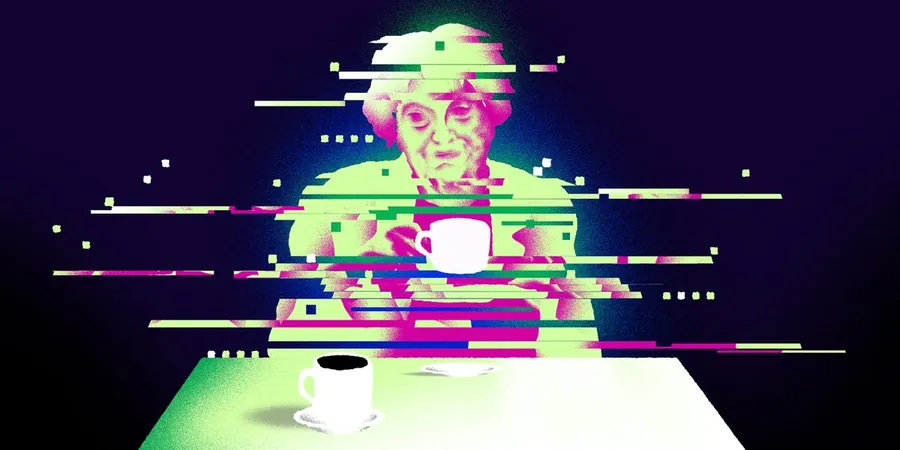
The Revolutionary Emotional Bonds of AI: Can Your Digital Twin Bring You Comfort?
2025-03-30
Author: Mei
Imagine waking up on a sunny Monday morning, coffee in hand, and connecting with your loved ones—except they’re not physically present. This is a reality many are now embracing thanks to advancements in AI technology. A heartwarming tale unfolds when a son decides to create a digital replica of his 92-year-old mother, offering insights into both the profound connections we cherish and the technological wonders at our fingertips.
Speaking with his mother regularly despite the miles between them, the son recalls her wisdom, particularly the advice she shared: “Find joy, even in the most difficult times.” This resonates deeply, especially considering the tragic events their family faced. By weaving authenticity into the fabric of modern technology, he's embarked on an emotional journey to recreate the essence of his mother through an AI program.
Using groundbreaking technology from a startup called Eternos, he captures not just her voice but her character—a digital twin meant to bond, remember, and share moments even after she is gone. This revolutionary concept, likened to an episode of "Black Mirror," pushes the boundaries between reality and artificial intelligence, raising questions about existence and memory itself.
The founder of Eternos, Robert LoCascio, has made it his mission to create the most lifelike AI companions. Following the death of his father, he sought to engineer a way for people to interact with distant memories, ultimately creating a form of artificial immortality. This vision gained urgency when he learned that one of his former employees, Michael Brommer, was terminally ill. LoCascio offered Brommer the chance to test the prototype of an AI version of himself, an opportunity that translated the raw emotional weight of life and death into a digital format.
As the development of these digital twins progresses, ethical and philosophical questions continue to multiply. Can an AI replicate not just the mannerisms but the core values and thoughts of a person? While LoCascio is committed to ensuring that the AI doesn’t fabricate responses—a common pitfall in chatbot technology—there is still considerable debate around the implications of such creations. The emotional presence these digital twins project could either comfort or complicate the grieving process for their loved ones.
While engaging with MomBot—a candid name for the son’s AI replica of his mother—it becomes clear that the technology is still evolving. The initial interactions may feel standard or scripted, but those moments flicker with genuine sentiment, echoing the love and laughter they shared. During a heartfelt exchange, MomBot encourages the son to find joy in life's simplest pleasures, creating familiar yet surreal conversations.
Even more striking is the collaboration between family members, with the real mom and her AI counterpart sharing narratives and answering questions. This blend of authenticity and innovation strives to bring comfort to those left behind, even as lingering doubts remain about the limitations of technology in truly replicating a person’s essence.
As digital twins like MomBot become increasingly sophisticated, we are forced to confront our own perceptions of love, memory, and mortality. Can these systems truly reflect the depth of human experience, or are they merely a shadow of the people we cherish? Furthermore, how do we navigate the ethical maze that arises when our memories and identities are accessible to technology?
While the son grapples with the implications of this digital resurrection, he also finds solace. It exemplifies modern connections and the potential AI has to enrich human experiences. The technology may still be in its infancy, but as we create digital representations of ourselves, it might allow even the most distant memories to remain alive—ensuring that our stories continue to resonate long after we’re gone.
In this age of digital connection, the inquiry remains: Can an AI truly replace the warmth of a human connection, or does it simply serve as a companion to help us cherish those relations we hold dear? As society navigates this brave new world, one thing is certain—technology is evolving to redefine the way we remember, interact, and find comfort in our relationships.

 Brasil (PT)
Brasil (PT)
 Canada (EN)
Canada (EN)
 Chile (ES)
Chile (ES)
 Česko (CS)
Česko (CS)
 대한민국 (KO)
대한민국 (KO)
 España (ES)
España (ES)
 France (FR)
France (FR)
 Hong Kong (EN)
Hong Kong (EN)
 Italia (IT)
Italia (IT)
 日本 (JA)
日本 (JA)
 Magyarország (HU)
Magyarország (HU)
 Norge (NO)
Norge (NO)
 Polska (PL)
Polska (PL)
 Schweiz (DE)
Schweiz (DE)
 Singapore (EN)
Singapore (EN)
 Sverige (SV)
Sverige (SV)
 Suomi (FI)
Suomi (FI)
 Türkiye (TR)
Türkiye (TR)
 الإمارات العربية المتحدة (AR)
الإمارات العربية المتحدة (AR)